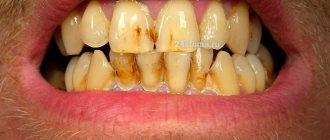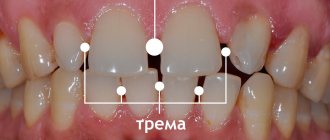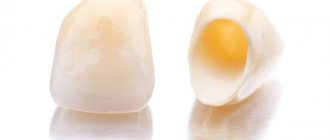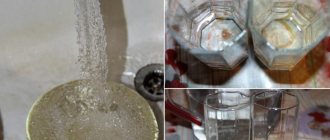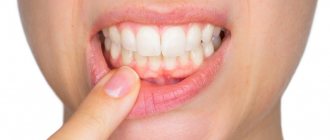Author of the article:
Soldatova Lyudmila Nikolaevna
Candidate of Medical Sciences, Professor of the Department of Clinical Dentistry of the St. Petersburg Medical and Social Institute, Chief Physician of the Alfa-Dent Dental Clinic, St. Petersburg
Today, almost everyone knows that teeth need especially careful care. We buy expensive pastes and use special thread. But, unfortunately, when taking care of our teeth, we completely forget about the tissues surrounding them, while the health of our gums needs to be monitored no less carefully.
Many people are familiar with the symptoms when the gums begin to hurt when pressing between the teeth. And many, unfortunately, ignore this unpleasant pain. Let's figure out what can cause it, what these sensations indicate, and how to relieve unpleasant symptoms.
Causes of pain in the gums when pressing
Remember, discomfort in your gums is a reason to see a dentist. No matter what kind of pain you feel, relatively mild or severe, you need to determine the cause of the problem as soon as possible and begin treating it.
As a rule, pain in the gums when pressed is provoked by three diseases:
- Gingivitis. This disease is accompanied by swelling of the mucous membrane and bleeding. Inflammation is provoked by microbial plaque, which occurs due to non-compliance or improper oral hygiene.
- Periodontitis. The disease, as a rule, is accompanied not only by unpleasant sensations, but also by a general deterioration in well-being. The patient feels which tooth is bothering him, as his “elevation” is felt above the other teeth.
- Periodontitis. The disease occurs due to untreated gingivitis. With periodontitis, the necks of the teeth open, pus oozes from the gums, and the teeth become mobile. The problem affects the entire cavity and can lead to tooth loss.
Why are my gums swollen and sore?
In this article, we will help you figure out why your gums around the tooth are swollen, and how exactly it will be necessary to treat this tooth. Below we will list the symptoms that will allow you to make the correct diagnosis, but first take a close look at the teeth adjacent to the swelling in the mirror. In most cases, the gums swell precisely in the projection of the causative tooth. You need to define the following −
- whether toothache in one of the teeth preceded the appearance of gum swelling,
- does pain appear in one of the teeth when biting on it,
- whether the tooth has decay, a filling or a crown,
- Is this tooth movable?
- does pus discharge from under the gums - when you lightly press on the swelling.
Next, by comparing your symptoms with the symptoms characteristic of periodontitis or periodontitis (which we described below) - you can understand the cause of the inflammation and what treatment you will need in this case.
Treatment of gum pain
It is important to treat gum disease as soon as possible. Any, even the most harmless pathology, can turn into periostitis with high fever, swelling of the mucous membranes and loose teeth. Moreover, inflammation in the gums releases toxins that provoke the development of blood poisoning.
You should not discount the possibility of pain in the gums when pressing due to illiterate treatment by a dentist. Normally, pain after treatment persists for 1-2 weeks. If the pain continues longer and does not subside, it is important to see a doctor as soon as possible. It happens that after poor-quality dental canal filling, bacteria appear in the voids, which provoke an infectious process.
The dentist may also leave the edges of the filling uneven, causing damage to the gums. In this case, you should definitely consult a doctor so that he can improve his work.
Attacks of pain when pressing on the gums are also common with increased sensitivity of the teeth and gums. However, with proper care, this pain goes away quite quickly. When it occurs, you should use toothpastes and rinses for sensitive teeth.
For example, ASEPTA Sensitive preventive toothpaste allows you to perform oral hygiene without irritating sensitive gums. The combination of 3 desensitizing components - potassium citrate, hydroxyapatite, thermal mud - significantly reduces the sensitivity of teeth and gums.
For more effective prevention of pain in the oral cavity, it is recommended to use ASEPTA gum gel with propolis. In this product, propolis is produced in the form of a gel, which makes it easy to apply to the gums. Prolonged contact with the painful area of the gum allows the gel components to penetrate deeper and promotes rapid healing.
The cause of pain when pressing on the gums can also be various injuries to the gums and teeth, received, for example, when trying to crack nuts or toffee. Such injuries also need to be shown to the dentist as soon as possible, otherwise there is a possibility of an inflammatory process.
Gum inflammation: patient mistakes
Working as a periodontist, I observed thousands of patients with gum inflammation, and in most cases, patients came with severe forms of the disease and complications that could have been avoided (if treated in a timely manner). Mostly patients make the following mistakes:
1) When periodontitis or gingivitis develops, only antiseptic rinses and applications of gels to the gums are used, but they ignore the need to remove dental plaque using ultrasound at a dentist’s appointment. This situation leads to chronic inflammation, and if the patient only had gingivitis, then thanks to self-medication it will turn into periodontitis. If the patient already has periodontitis, this only threatens to worsen its shape, cause tooth mobility and pose a threat of the need to remove them.
2) Patients often think that antiseptics and antibiotics are enough to control gum inflammation, and therefore use them in regular courses (ignoring the need to remove the cause of inflammation). Remember that even long-term use of antiseptics and antibiotics does not allow complete “disinfection” of dental plaque, periodontal pockets or root canals in the tooth. All this acts only superficially and has a temporary effect.
3) With slight inflammation of the gums in the area of 1-2 teeth, patients often do not go to the dentist at all, but constantly rinse their mouths with antiseptics and smear various gels on the gums. Please note that if inflammation of the gum is caused by the presence of “supercontacts” or injury to it by the overhanging edges of fillings/crowns (we are talking about a localized form of periodontitis), then anti-inflammatory therapy will not stop the process of bone destruction around the tooth at all - until the factor traumatic to the gums is eliminated. Those. You still have to go to the dentist.
4) If you experience periodic swelling of the gums in the area of 1-2 teeth due to periodontitis, then anti-inflammatory drug therapy (including antibiotic therapy) is completely useless. In this case, inflammation is caused by an infection in the root canals, and until the root canals of this tooth are properly filled, the inflammation will not go away.
Important: therefore, it is very important to understand that treatment at home can be effective - only in terms of conducting a course of anti-inflammatory therapy for gingivitis and periodontitis (after removing plaque from the dentist). Home treatment can also be used to strengthen the gums - during periods between the main courses of anti-inflammatory therapy, but in this case, products that do not contain antiseptics and antibiotics should be used.
How to relieve pain when pressing on the gums
Remember, only a dentist can help eradicate the pain experienced when pressing on the gums or teeth. It is important to quickly determine the cause of the discomfort and prescribe proper treatment. However, to eliminate discomfort before visiting a doctor, you can try the following methods:
- Take painkillers, such as paracetamol or analgin. The main thing is not to overdo it with such drugs, as they can be addictive and negatively affect the functioning of internal organs.
- Brush your teeth properly, trying to free the inflamed cavity from plaque and food particles.
- Rinse your mouth with a solution of baking soda, furatsilin or potassium permanganate.
Remember, it is strictly forbidden to warm your cheeks and gums or apply warm compresses to the sore spot. Heat can trigger more severe inflammation. Also, you should not take antibacterial or anti-inflammatory drugs without a doctor’s prescription.
It is also prohibited to put analgesics into the cavity of a diseased tooth. This popular method is far from safe: you can not only cause an infection, but also get a serious burn to the mucous membrane.
Diagnosis and treatment
To determine the cause of pain, dentists conduct a visual and instrumental examination of the oral cavity. To confirm the diagnosis you may need:
- overview x-ray of the upper or lower jaw,
- results of a general blood test and a smear from the oral mucosa,
- cytological examination of the contents of periodontal pockets.
The treatment regimen is drawn up individually for each patient, taking into account the diagnosis and clinical picture.
Treatment for gum pain
The treatment tactics for pain in the gums when pressing depends on the cause of the disease. If the pain appears due to problems with the teeth, the canals are filled or refilled. The doctor removes the source of inflammation. Advanced stages of the disease are treated with surgery and removal of the diseased tooth.
If the cause of pain in the gums when pressing is their inflammation, it can be relieved with medications prescribed by the dentist. As a rule, in such cases, the doctor prescribes antibiotics or other penicillin drugs. Rinse must be prescribed.
Folk remedies – decoctions of medicinal herbs – also help relieve pain and inflammation. Oak bark, chamomile, and sage perfectly remove unpleasant sensations. A solution of baking soda with a few drops of iodine also helps relieve inflammation.
Other popular methods for treating inflammation at home are:
- Propolis tincture
has antibacterial and antimicrobial effects. To prepare it, dilute a teaspoon of tincture in 200 ml of water. You need to rinse your mouth with propolis up to five times a day. - Massage with oils
has a beneficial effect on the gums. It is not at all difficult to do: apply a few drops of tea tree, eucalyptus, juniper or fir oil to the pads of the thumb and index fingers of one hand. You need to massage the gums gently for 5-10 minutes. After the massage, you should not rinse your mouth. - Aloe
also contains many anti-inflammatory components. For gingivitis or stomatitis, you can chew a fresh leaf of this plant a couple of times a day.
What to do if your denture rubs
It’s not just the first days of installation that are difficult for many patients. Often, removable dentures constantly rub against the gums due to their irregular shape. In this case, therapeutic treatment will not be successful, so dentists carry out a correction or a complete change of the prosthesis.
The plate is filed at the points of contact with the mucous membrane. Thus, the load on the gums will be redistributed and the problem will be solved.
After the manipulations, the specialist recommends a remedy to relieve inflammation caused by rubbing. For example, a gel for lubricating gums. It is important to see a doctor immediately, otherwise complications are possible - inflammation of the inner layers of the jaw apparatus, healthy periodontal tissues.
Nutrition: prevention of inflammation
If gingivitis is the cause of pain when pressing on your gums, it is important to review your diet by including healthy foods in your diet. To prevent future diseases, first of all, you need to consume plenty of fresh fruits and vegetables:
- Apples and pears contain a lot of pectin, which helps accelerate tissue regeneration.
- Citrus fruits are a real storehouse of vitamin C, which also helps reduce bleeding and inflammation.
- Black currants, blackberries, and raspberries contain a large amount of minerals and vitamins that increase the body's resistance.
- Carrots, cabbage and zucchini are valuable fiber and vitamins that enhance metabolic processes in the body and accelerate tissue regeneration.
To prevent gum inflammation, professional teeth cleaning is also recommended. The procedure is carried out by a dentist and allows you to eliminate all accumulated deposits and tartar.
So, now you know the most common causes of pain in the gums when pressing. Remember: when your gums or teeth bother you, you should never put off visiting the dentist. The sooner the doctor determines the cause of the problem and begins treatment, the greater your chances of saving your teeth, gums and avoiding possible complications.
Sources:
- The role of anti-inflammatory rinse in the treatment of periodontal diseases (L.Yu. Orekhova, A.A. Leontyev, S.B. Ulitovsky) L.Yu. OREKHOVA, Doctor of Medical Sciences, Prof., Head of Department; A.A. LEONTIEV, dentist; S.B. ULITOVSKY, Doctor of Medical Sciences, Prof. Department of Therapeutic Dentistry of St. Petersburg State Medical University named after. acad. I. P. Pavlova
- Clinical studies of antisensitive toothpaste “Asepta Sensitive” (A.A. Leontyev, O.V. Kalinina, S.B. Ulitovsky) A.A. LEONTIEV, dentist O.V. KALININA, dentist S.B. ULITOVSKY, Doctor of Medical Sciences, Prof. Department of Therapeutic Dentistry, St. Petersburg State Medical University named after. acad. I.P. Pavlova
- The effectiveness of the use of Asept “adhesive balm” and Asept “gel with propolis” in the treatment of chronic generalized periodontitis and gingivitis in the acute stage (Municipal Dental Clinic No. 4, Bryansk, Kaminskaya T. M. Head of the therapeutic department Kaminskaya Tatyana Mikhailovna MUZ City Dental Clinic No. 4, Bryansk
Signs that your gums are inflamed
To decide what to do if the gums under the denture become inflamed, it is necessary to correctly diagnose the pathology.
The main symptoms indicating an inflammatory process are:
- Redness appears in the prosthetic area. It can spread to surrounding tissues.
- Drops of blood are noticeable when brushing your teeth, turning into constant bleeding.
- Feeling of discomfort, pain when chewing food.
- It is possible to relieve inflammation for several hours, then the situation worsens again.
- Gradually, bad breath begins to appear, which does not disappear after the usual procedure of brushing your teeth.
- The tongue feels swelling of the gums.
If the situation repeats frequently, then the pathology is likely complicated. In advanced cases, the main symptoms include chills, hyperemia of the surrounding gum tissue, increased body temperature, and the gums of the entire part of the dentition become inflamed.
The patient may notice a change in the angle of the artificial tooth, as well as the appearance of gum pockets. Pieces of food get into them, which creates a negative environment for the proliferation of harmful bacteria.
In case of an allergic reaction to the prosthetic material, a rash, burning, dryness, and itching on the skin of the face is observed. You should immediately seek help from your doctor.
Why do ulcers appear on the gums, and is it always dangerous?
There are many possible reasons. To understand how dangerous the appearance of certain lesions on the gums is, you need to look at additional accompanying symptoms:
- in case it is trivial mechanical damage. The gums can be damaged by hard food, a toothbrush, or a foreign object. These lesions may resolve in 3-5 days. If a person does not brush his teeth, then infection is added to these damages, and healing may take several weeks.
- Sometimes ulcers can appear as a result of wearing orthodontic structures, braces or removable dentures.
Reasons for the inconvenient placement of the prosthesis
The main reasons for the appearance of severe discomfort while wearing an orthopedic system include the following factors:
- psychological unpreparedness of the patient for dentures,
- incorrectly manufactured design,
- initially inflamed gums, which were not treated,
- poor hygienic care of the structure and the entire oral cavity,
- features of the condition of the temporomandibular joint,
- uneven relief of the alveolar ridge.
The most common diseases of the oral cavity in which ulcers appear
- ulcerative necrotizing gingivitis. The cause of this disease is bacteria that multiply when immunity decreases. Extensive ulcers appear on the gums, regional lymph nodes become enlarged, and the temperature may rise
- chronic recurrent aphthous stomatitis. Up to 4-5 white spots first appear in the mouth, which later turn into ulcers. There is no temperature or other problems related to well-being. If such symptoms appear 1-2 times a year in small quantities, then there should be no cause for concern. Frequent occurrence is associated with weakened immunity and possible intestinal diseases, as well as allergies.
- acute herpetic stomatitis. Herpetic stomatitis occurs in a child when he first encounters the herpes virus. Many bubbles appear on the gums, which, after bursting, turn into ulcers that merge with each other. The gums are always bright red, and the ulcers themselves are very painful, the temperature may rise


